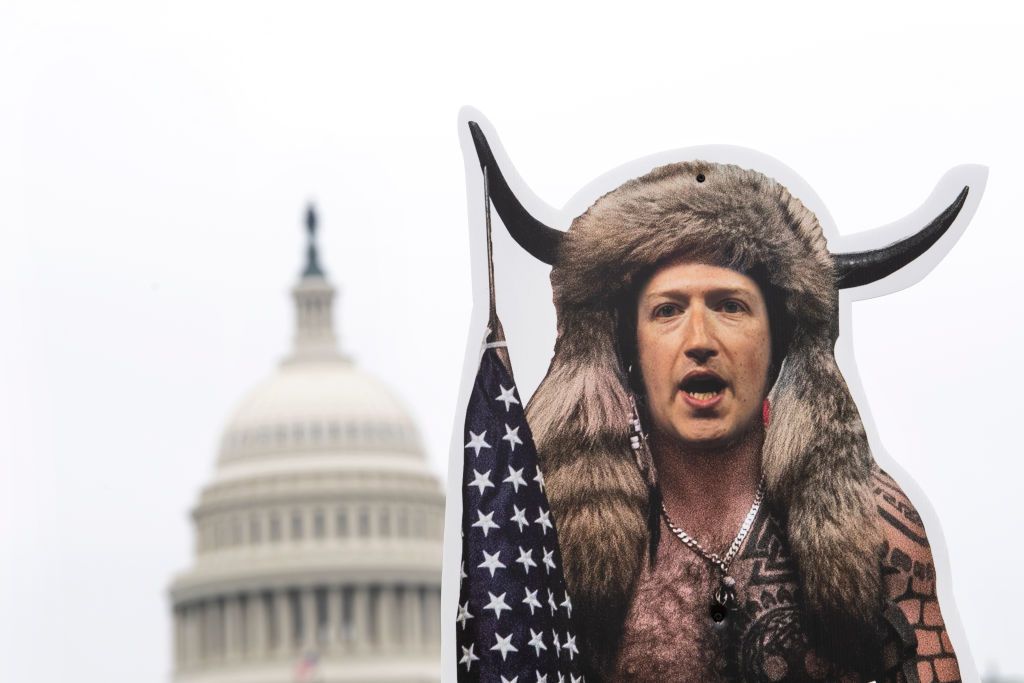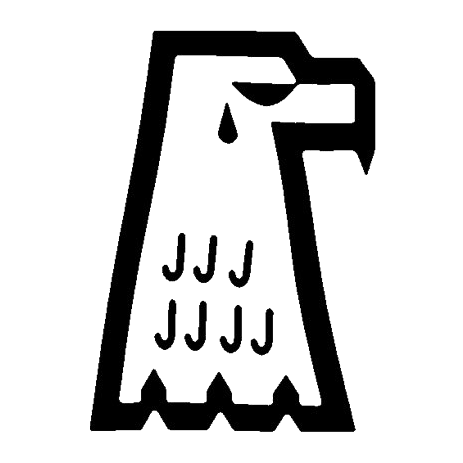Terrorism, Structural Racism, And Facebook
The ‘radical indifference’ of the surveillance-capitalist giant reflects and entrenches a racialized understanding of political violence.


Edited by Sam Thielman
Buy REIGN OF TERROR: How The 9/11 Era Destabilized America and Produced Trump
FACEBOOK, ONE OF THE WORLD’S WORST MALEFACTORS, is experiencing a crisis of exposure.
The whistleblower Frances Haugen has, in Charlie Warzel’s estimation, maneuvered the surveillance-capitalist giant into perilous territory by exposing the ways its systems are architected to produce misinformation and harm. Facebook is not agnostic about what you see; rather, what you see results from choices its algorithms make for you, at scale. But it is radically indifferent about what you see, a concept coined by the Harvard Business School professor emerita Shoshana Zuboff. An expose by The Intercept’s Sam Biddle this week tallies some of the wages of radical indifference: the replication and entrenchment of structural racism in counterterrorism.
In her excellent book The Age of Surveillance Capitalism, Zuboff defines radical indifference—“a response to economic imperatives”—as the reduction of human experience “to measurable observable behavior while remaining steadfastly indifferent to the meaning of that experience… What passes for social relations and economic exchange now occurs across the medium of this roboticized veil of abstraction.” As this relates to misinformation and disinformation on Facebook, she continues: “[W]ith the application of radical indifference, content is judged by its volume, range, and depth of surplus as measured by the ‘anonymous’ equivalence of clicks, likes and dwell times, despite the obvious fact that its profoundly dissimilar meanings originate in distinct human situations.”
One legendary example of radical indifference is found in a memo produced by Facebook vice president Andrew Bosworth in 2016. “We connect people,” Bosworth begins, and, functionally, it’s where he ends. Sometimes people meet on Facebook and fall in love. That’s good. But “that can be bad if they make it negative” – and by “they” he means users, not the platform. “Maybe it costs a life by exposing someone to bullies. Maybe someone dies in a terrorist attack coordinated on our tools.” But, look: “The ugly truth is that we believe in connecting people so deeply that anything that allows us to connect more people more often is *de facto* good.”
Bosworth inadvertently described how economic interest drives ideology. “That’s why all the work we do in growth is justified,” he writes in the memo. “All the questionable contact importing practices... [M]ake no mistake, growth tactics are how we got here.” When humanity is extinct from capital-driven climate change, following a new dark age of capitalist authoritarianism borne on the leathery wings of social media, Growth Tactics Are How We Got Here should be engraved on our headstone.
Radical indifference as a growth tactic is also how Facebook emerged as the planet’s premier venue for reactionary political organizing. It’s also what shapes Facebook’s response to that emergence: the blacklists that Biddle’s reporting exposed. But not all blacklists are equal—especially not when they distinguish between “terrorists” and “militarized social movements.” While it might seem ironic that radical indifference manifests in such distinctions, the distinctions reveal how Facebook reinforces, at scale, structural racism.
APPLAUD FACEBOOK, for it has banned a terrorist supermarket. The Gambian supermarket chain Kairaba can do no business on the platform. Any “praise, substantive support, and representation” of the store and its “leaders, founders, or prominent members” will be removed, according to the latest iteration of Facebook’s “Dangerous Organizations” policy. That’s because, according to the 100-page blacklist document Biddle obtained and published, Facebook considers the Kairaba supermarket chain in Gambia to be a terrorist entity, against which its “most extensive enforcement” applies. That means that Kairaba falls within “Tier 1” on Facebook’s three tiers of blacklists, alongside ISIS and Al Qaeda. So does the Kanso Fishing Agency in Sierra Leone. Same with something called Lama Foods in Lebanon.
The reason Facebook considers these companies to be in the terror business and not, say, the food business is because the U.S. government designates them as such. The Treasury Department has them all under sanctions as money laundering fronts for Hezbollah. Facebook blacklists a Dubai company called Parthia Cargo LLC, which the Justice Department last year named in a criminal complaint for allegedly shipping commercial airplane parts to Iran in violation of sanctions. If convicted, the firm could be liable for up to half a million dollars in fines, but Facebook bans require no convictions.
We know Facebook models its terrorism blacklists on frameworks the U.S. government uses. Facebook tells us so. The company’s Tier 1 list includes “those designated by the United States government as Foreign Terrorist Organizations (FTOs) or Specially Designated Global Terrorists (SDGTs),” per the policy. Indeed, for more than a decade, Facebook and other surveillance-capitalist giants have liased with the U.S. government to remove jihadist content like Anwar al-Awlaki’s videos. That’s also roughly the timeframe of Facebook-and-them’s involvement in the NSA’s PRISM mass surveillance. When Facebook assembled an internal counterterrorism apparatus, it hired veterans of the U.S. Security State—and with them, the focus, prerogatives, and blind spots of the War on Terror they served and shaped. Brian Fishman, formerly of West Point’s Combatting Terrorism Center, currently runs the shop.
Facebook denied it to Biddle, but if you scroll through the blacklist document, it’s glaringly obvious that its categories are euphemisms for different kinds of people, not different kinds of behavior. “Terror” is how it describes Muslims’ political violence. White people’s political violence, in the U.S. and Europe, is “Hate.” There are exceptions to each of the categories—Facebook lists the organization of the Jewish fascist Meir Kahane under terror—but the overall breakdown is undeniable. Dozens of American right-wing organizations are listed not as terror, but as “Militarized Social Movement/Armed Militia Groups,” according to the document.
The contortions of the blacklist are at times delicious. Examples of armed militia groups that aren’t terrorists are: Americans Against Terrorism and Tyranny; the Anti-Terrorism Militia; the United States Anti-Terrorism Militia; and, perhaps my favorite, the Anti-Antifa Militia Organization of Wisconsin.
“Hate” groups can come in for Tier 1 sanctions, according to the Facebook policy document. But not so, the document states, for “Militarized Social Movement/Armed Militia Groups,” which are in Tier 3. (I note here that many of the Tier 1 “Hate” groups are white-power bands.) Such groups “may not have a presence or coordinate on our platforms” but, in contrast to Tier 1, supporters can apparently praise them without coming in for deletions, blacklists, deplatformings, and so forth. This won’t ever be stated in a policy document, but PRISM surveillance likely does not apply to them either.
The distinction, according to the policy, is that Militarized Social Movement/Armed Militia Groups, unlike terrorist entities, “have not necessarily engaged in violence to date or advocated for violence against others based on their protected characteristics.” I would be interested to hear more about how Kairaba Supermarket engages in violence or advocates for violence against others based on their protected characteristics but something called the Army of the Christ—whose website sounds “a call to arms for ALL CHRISTIANS around the world to fight alongside Christians and defend Holy Lands”—doesn’t. Even Varg Vikernes is in Tier 1!
I suspect several of these “Militarized Social Movement/Armed Militia Groups” don’t really exist beyond the internet. Some may not be more than keywords that an algorithm flags, like one called the “Conservative American News Militia,” something that appears not to live off-platform. Other listings are just straight up wrong, like calling the anarchist collective CrimethInc. an armed militia. I’ve written for CrimethInc. publications, played with CrimethInc. bands and slept on the couches of CrimethInc. contributors. Categorizing CrimethInc. in such terms is a false equivalence that treats people who feed unhoused youth (and who might carry the odd wrench during a protest) as a danger on par with something called the Deplorable Patriots III% Militia. Such radical indifference—a growth tactic, remember—is useful in a political environment where the III% movement has allies in statehouses and Congress while CrimethInc. does not.
FACEBOOK DID NOT INVENT the American-Exceptionalist myopia around political violence. It simply reflects the post-9/11 environment it inhabits. The U.S. government does not consider right-wing American militias to be a threat meriting the level of censorship shown to a supermarket in Gambia, therefore neither does Facebook. Mechanisms of the U.S. Security State, like the terrorism designations, treat terrorism as primarily a Muslim phenomenon, while there is no such designation for domestic white organizations that are flexible about using violence as a tool of political dispute. Facebook follows that lead.
But Facebook has nearly three billion monthly users. By taking its cues from the institutions and political culture of the War on Terror, Facebook amplifies its prerogatives globally— most urgently, its prerogatives about whose political violence counts as terrorism, whose does not, and whose requires sanction. The distinctions drawn here reflect blind spots, yes, but they also reflect growth tactics. They reveal choices about whose presence on the platform is valuable and whose isn’t.
Here we see the structural racism at work in the intersection of counterterrorism and surveillance capitalism. A privately profitable forum of such unfathomable scale, rooted in one specific culture and influencing all others, could hardly be otherwise.
It seems self-evident to me that a constellation of social media platforms with global reach, like Facebook, should not be permitted to exist. There are no meaningful constraints on something that poses so profound a threat to freedom. Laws and politicians accommodate corporations of such size, they don’t constrain them. The right doesn’t want to break Facebook up, it wants to intimidate and suborn Facebook while leveraging its scale for messaging and organizing. (Though we can pause to laugh at the leaders of the Let The Market Eat People’s Faces Party when they realize the market might eat their faces.)
Facebook will be far more responsive to such pressure than it will any pressure to mitigate its own risk to democracy, since true mitigation comes from limiting Facebook’s reach. And growth tactics are how we got here.

